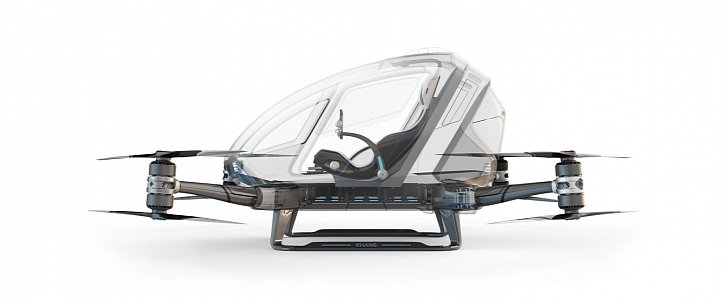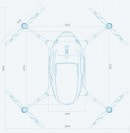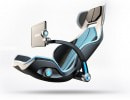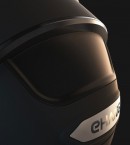Meet Ehang 184, the world's first passenger drone, an electric aerial vehicle (AAV) that will soon be seen above the cities. The Ehang 184 is set to enter mass production soon, even though no details on price or availability have been yet disclosed.
Made from aeronautical-grade aluminium and composite carbon fiber and epoxy resin panels, Ehang 184 packs reassuring structural strength while maintaining a low weight. Also, the clever design maximizes the interior space, accommodating a rider and a 16" bag.
This drone is equipped with no less than eight rotors, with two stacked motors in each corner delivering thrust and precise directional control. Ehang reassures us that the safety routines integrated with the machine and thoroughly tested are top-notch.
The crucial systems are redundant, so the Ehang 184 will keep operating an emergency flight plan to keep both passenger and vehicle safe. In case of a defect, the drone will automatically slow down, descend and land in the nearest area that allows this.
Ehang 184 weighs 200 kg (441 lb) and can carry a payload half as heavy. If you're a massive individual, you might have to wait a bit longer until Ehang improves the AAV technology, but it won't be that long now.
The eight motors pack 106 kW (142 hp) and can propel the Ehang 184 at a top speed of 100 km/h (62 mph), with the maximum altitude being 500 meters (1,640 ft). A full charge can deliver up to 23 minutes of flight, and if that refers to full-speed flight, commuting using this drone no longer sounds like a Sci-Fi movie scene. A full recharge takes up to 4 hours so that the fun can carry on after work, as well.
A tablet and an intuitive app cater to the human-machine interface, and flying the Ehang 184 does not require extensive training as everything is automated. The operator can, however, chose AC temperature, ambient and external lights, or set the balanced or eco flight mode. As for stability, the vehicle itself takes care of external factors, ensuring a smooth and steady flight even in windy conditions.
Now that the first passenger drone is here (give or take), and the window towards flying motorcycles is wider, we're eagerly waiting for them. Maybe using a BMW boxer engine for an aero motorcycle is not exactly the best idea...
This drone is equipped with no less than eight rotors, with two stacked motors in each corner delivering thrust and precise directional control. Ehang reassures us that the safety routines integrated with the machine and thoroughly tested are top-notch.
The crucial systems are redundant, so the Ehang 184 will keep operating an emergency flight plan to keep both passenger and vehicle safe. In case of a defect, the drone will automatically slow down, descend and land in the nearest area that allows this.
Ehang 184 weighs 200 kg (441 lb) and can carry a payload half as heavy. If you're a massive individual, you might have to wait a bit longer until Ehang improves the AAV technology, but it won't be that long now.
The eight motors pack 106 kW (142 hp) and can propel the Ehang 184 at a top speed of 100 km/h (62 mph), with the maximum altitude being 500 meters (1,640 ft). A full charge can deliver up to 23 minutes of flight, and if that refers to full-speed flight, commuting using this drone no longer sounds like a Sci-Fi movie scene. A full recharge takes up to 4 hours so that the fun can carry on after work, as well.
A tablet and an intuitive app cater to the human-machine interface, and flying the Ehang 184 does not require extensive training as everything is automated. The operator can, however, chose AC temperature, ambient and external lights, or set the balanced or eco flight mode. As for stability, the vehicle itself takes care of external factors, ensuring a smooth and steady flight even in windy conditions.
Now that the first passenger drone is here (give or take), and the window towards flying motorcycles is wider, we're eagerly waiting for them. Maybe using a BMW boxer engine for an aero motorcycle is not exactly the best idea...

















